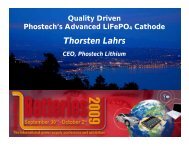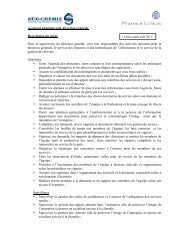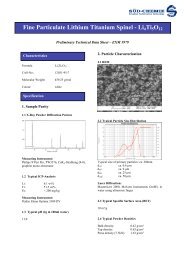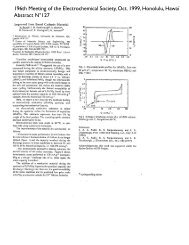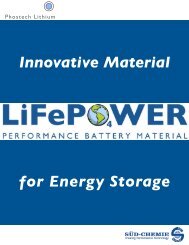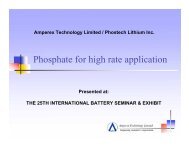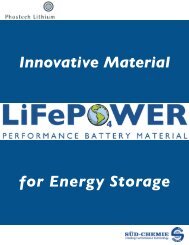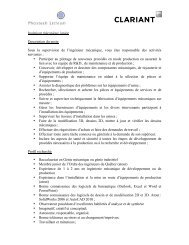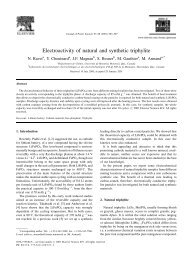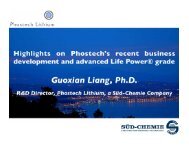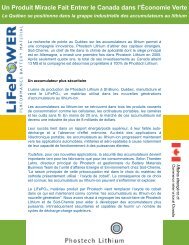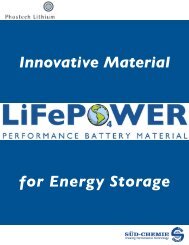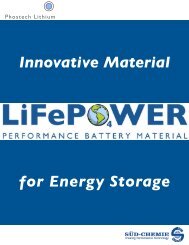Saft SuperPhosphate - Phostech Lithium inc.
Saft SuperPhosphate - Phostech Lithium inc.
Saft SuperPhosphate - Phostech Lithium inc.
- No tags were found...
You also want an ePaper? Increase the reach of your titles
YUMPU automatically turns print PDFs into web optimized ePapers that Google loves.
1<strong>Saft</strong> <strong>SuperPhosphate</strong>Bridget Deveney, Sarah Rickman, Kamen NechevSAFT America Inc., Cockeysville, MDRichard Jow, Kang Xu,Army Research Laboratory
An International manufacturing networkclose to its customers3MilwaukeeNorth HavenPort WashingtonCockeysvilleValdeseOsteraasVäjxöOskarshamnCoatbridgeSouth ShieldsHarlow BüdingenPoznanEindhovenHanoverNurnberg PragueBagnoletRaskoviceBourgesPoitiersNersac MilanBordeauxMoscowShanghaïHong KongZhuhaïBangaloreSingaporeValdostaMadridWest Palm BeachLimassolBnei-BrackKyriat-EkronSydneySpecialty Battery Group production siteIndustrial Battery Group production siteRechargeable Battery Systems production site<strong>Saft</strong> sales networkASB (50% <strong>Saft</strong>, 50% EADS)Johnson Controls-<strong>Saft</strong> (<strong>Saft</strong> 49% <strong>Saft</strong>, Johnson Controls Inc. 51%)
5Specialty Battery Group40%of Group turnover <strong>Saft</strong>’s Specialty Batteries Group (SBG)division is the world leader in the design andmanufacture of high-performance primarylithium and rechargeable Li-ion batteries forthe electronics, defense and spaceindustries. SBG also supplies rechargeable and nonrechargeablesilver-based batteries forconventional defense applications (missilesand torpedoes).€240.8 MSales 200821.4%EBITDA marginMain applications:satellites, utility meters, medicalequipment, launchers, missiles,torpedoes, asset tracking, sonarbuoys, military radios, night visiongoggles, electronic toll collection.
6Research and Development The quality of its R&D teams is one of the Group’smajor competitive strengths, allowing it to maintainthe technological leadership; <strong>Saft</strong> invests between 5% and 6% of annual sales inR&D <strong>inc</strong>luding customer funded development, andgrants. Applied research programs employ 50 people,located mainly in Bordeaux (France) andCockeysville (US).The development teams on the various productionsites employed more than 300 people at end 2008.
7Joint ventures<strong>Saft</strong> has a significant shareholding in two associated companies Johnson Controls-<strong>Saft</strong> Advanced Power Solutions <strong>Saft</strong> leveraged its technological expertise to set up a joint venture in 2006with the US firm Johnson Controls Inc., a Tier-1 automobile supplier, toaddress the fast-growing EV and HEV market on Li-ion expertise.The joint venture has already won production contracts in Europe, the USand China. Group ASBThe group manufactures thermal batteries for the defense industry hastwo subsidiaries: MSB in Scotland,ATB in the United StatesASB is the leading supplier in Europe.
8About the Space & Defense Division (SDD) <strong>Saft</strong> Space & Defense Division(SDD) specializes in theresearch, design andmanufacturing of advancedlithium-ion battery systems. SDD develops andmanufactures the highestpower density battery cells inthe world. SDD is the U.S.’s largestsupplier of Li-ion batteries forspace and for hybrid electricmilitary vehicles.
SAFT SDD Cockeysville9• Located 26 mi north of BWI off I-83•Total Area: 49,000 ft 2 (~4,900 m 2 )•Dryroom Area: 6,000 ft 2 (~600 m 2 )•Production Line capable of producing~75,000 high energy (VL-E), mediumrange (VL-M), high power (VL-P) andvery high power (VL-HP) lithium ioncells per year delivered as completesystems.•Battery research, development andproduction, <strong>inc</strong>luding CANBus andBMS electronics, are part of the knowhowand service to provide CompleteSolutions.
10Production Capabilities The factory has state-of-theartequipment for fullautomation. All electrode production is keptin-house Production activities <strong>inc</strong>lude:Cell assemblyFill, formation and testModule assemblyBattery assembly
11<strong>Saft</strong> SDD <strong>Lithium</strong> Ion CellsCell RationalizationCell Classification CapacityDischarge Power (kW/kg)200 ms 2 sec ContinuousSpecificEnergy(Wh/kg)MaximumDischarge(continuous at25°C)VL3A Very high power 3Ah 15 9 6 57 350VL6A Very high power 6Ah 12 7 6 64 750VL12V Very high power 14Ah 12 7 6 74 1500VL22V Very high power 23Ah 14 9 6 84 2500VL10VFe Very high power (LiFePO 4 ) 11Ah 7 5 4.5 57 1500VL34P High power 33Ah 9 7.2 1.9 120 500VL25PFe High power (LiFePO 4 ) 26Ah 1.7 1.7 1.7 85 500VL52E High Energy 52Ah 0.19 185 52VL40EFe High Energy (LiFePO 4 ) 40Ah 0.17 132 50 Cells share mechanical designs, parts, materials Default is always to be like other products- in SDD AND in <strong>Saft</strong> Large advantage in speed to development and purchasing
12Technology ComparisonCell VL10Fe VL12V VL25Fe VL34PCathode LiFePO 4 NCA LiFePO 4 NCANominal Voltage (V) 3.3 3.6 3.3 3.6Nominal Capacity at C rate (Ah) 10 12 25 33V = f(SOC) at 50% DoD at C rate (mV/SOC%) 0.13 0.66 0.13 0.66Maximum Discharge Current at 25°C (A)Continuous 1500 1500 1200 5002s Pulse 1700 2200 2200 1900200ms pulse 2200 3200 2300 2400Specific Energy (Wh/kg) 54 74 89 120Energy Density (Wh/L) 128 175 189 280Specific Power at 25°C 100% SOC (W/kg)Continuous 4375 4600 3150 19002s Pulse 5000 6800 4400 7200200ms Pulse 6400 10,000 4600 9000ProsReal benefits tosafetyFlat voltageProsBest powerExcellent energyEstablishedtechnologyConsLower voltageLower energyand powerConsMore energeticreaction toabuse
13<strong>Saft</strong> LiFePO 4Products3.83.6500W Constant Power DischargeVL10VFe vs VL25PFe3.43.2Voltage (V)32.82.62.42.22VL25PFeVL10VFe0 1 2 3 4 5 6 7 8 9 10Time (min) VL10VFe offers excellent power and low heat generation for very highrate applications VL25PFe offers a balance of power and energy still with low heatgeneration for medium power applications
14LiFePO 4Development at SAFT SAFT started working on LiFePO 4 chemistry in 2005 under aprogram with Army Research Laboratory, continued the workunder MANTECH (US Army) and currently SAFT is internallyfunding the continuing development of LiFePO 4 productportfolio. <strong>Saft</strong> LiFePO4 cells use standard cell hardware so a wide range ofcell sizes and types is available with low NRE SAFT is using material from <strong>Phostech</strong>, which is currently theonly licensed supplier of the material by University of Texas. In 2009 <strong>Saft</strong> introduced our <strong>SuperPhosphate</strong>technology
15<strong>Saft</strong> <strong>SuperPhosphate</strong>4Continuous Discharge of VL10VFe and VL12VFe Cells at 25°C750ACurrent(A)3.532.521.510.50Superphosphate VL10VFeOlder VL10VFeVL12V0 2 4 6 8 10 12Capacity (Ah)<strong>SuperPhosphate</strong> improves the Power, Energy, ANDAbuse tolerance of average Iron Phosphate
16LiFePO 4Cells – Low Temperature Low temperature performance is critical for Li-ion batteries in militaryapplications. The natural limitations of the LiFePO 4material were overcome in thedevelopment phase by electrode design (porosity and type of conductiveadditives) Electrolyte in these cellshas also been optimized forlow temperature operation.43.753.53.253VL25PFe125ACell Voltage2.752.52.2521.751.51.25125°C0°C-10°C-20°C-40°C0 5 10 15 20 25Capacity (Ah)
17<strong>SuperPhosphate</strong> Low temperature4.5VL10VFe and Vl12V Discharge60A at -30°CVoltage (V)43.532.521.510.50Superphosphate VL10VFeVL12V0 2 4 6 8 10 12Capacity (Ah) Delivers full capacity even at -30°C
18Life of LiFePO 4Large Cells Life of LiFePO 4based systems is still being studied and evaluated. Cycle life testing is available and continuing. Calendar life testing is ongoing SAFT’s LiFePO 4calendar life is in line with life results fromcompetitorsOverall LiFePO 4calendar life appears to be somewhat inferior to<strong>Saft</strong>’s standard NCA chemistryStorage at temperatures above 45°C is not recommended foroptimal life
19Life of LiFePO 4Large Cells Pulse Power retention with ageing 2500 W/kg 18sec Discharge PP @ (70-100)% SOC & 25°C 1900 W/kg 18sec Charge PP @ (20-80)% SOC & 25° C Nearly no power loss after 700 full cycles @ 1C rate & 60°C4000350018 second Specific Discharge Power vs SOC at 25°C4000350018 second Specific Charge Power vs SOC at 25°C30003000Max Power (W/kg)2500200015001000Discharge PPMax Power (W/kg)2500200015001000Charge PP500New cellAged cell500New cellAged cell00% 20% 40% 60% 80% 100%SOC (%)00% 20% 40% 60% 80% 100%SOC (%)
20Choice of Chemistry - Life of Li-ion Cells Traditional layered oxide cathode materials (LiCoO 2, NCA, NMC, LiMn 2O 4 )have a proven long cycle and calendar life So far LiFePO 4is showing very good cycle life and acceptable calendar life LiFePO4 seems more sensitive to high temperature storage than layeredmetal oxides- climate control to below 45°C is important in storage.110%90%100%80%90%70%Capacity Loss (%)80%70%60%50%40%LiFePO4 capacityNCA CapacitylLiFePO4 ImpedanceNCA Impedance<strong>Saft</strong> High Energy CellCalendar Life Testing 100% SOC45°C60%50%40%30%20%Impedance Gain (%)30%10%20%0%10%-10%0 50 100 150 200 250 300 350 400 450Days
21Calendar Life Results120%110%100%90%<strong>Saft</strong> LiFePO 4 Energy CellsCalendar Life Testing100% SOC Various Temperatures100%90%80%70%Capacity Retention (%)80%70%60%50%40%<strong>Saft</strong> 45°C<strong>Saft</strong> 60°C<strong>Saft</strong> 72°C<strong>Saft</strong> 85°C45°C Impedance60°C Impedance72°C Impedance60%50%40%30%20%Impedance Gain (%)30%10%20%0%10%-10%0%-20%0 50 100 150 200 250 300 350 400 450 500Days Up to 72°C with minimal impedance growth
22Cycle Life of LiFePO 4cells110%100%1C 100% DOD Cycling of <strong>Saft</strong> High Energy LiFePO 4 CellsCycle Life of LFP CellsCapacity Retention (%)90%80%70%60%50%40%30%20%30°C45°C10%0 500 1000 1500 2000 2500 3000Cycle (#) Cells have excellent cycle life
2. <strong>Lithium</strong> Ion Safety23
24Safety by Design The three critical pillars of safety.LiNiCoAlO 2LiFePO 4HighEnergyHighPowerVeryHighPowerUltraHighPowerElectronicsandSoftwareMechanical
25Choice of Chemistry - Reactions in a Thermal EventGasHeatGasHeat Heat HeatPos.Positive materialdegradationReaction ofpositive with PVdFReactionwithC/COReaction withAluminumHeatGasSep/elect.Shut-downof theseparatorReactionsolvent/saltELECTROLYTEGasHeatGasHeatNEGATIVEELECTRODEPOSITIVEELECTRODENeg.Dissolutionof thepassivationlayerReaction betweenact. mat. & electrolyteReaction betweenact. mat. & binderT/°C100 300 500 700 900 1100
Choice of Chemistry - Reactions in a Thermal EventIron Phosphate Electrochemistry26Pos.No Reaction with Inert Iron Phosphate Positive MaterialHeatGasSep/elect.Shut-downof theseparatorReactionsolvent/saltELECTROLYTEGasHeatGasHeatNEGATIVEELECTRODENeg.Dissolutionof thepassivationlayerReaction betweenact. mat. & electrolyteReaction betweenact. mat. & binderT/°C100 300 500 700 900 1100
27Overcharge of VL25PFe Cell25A Overcharge of VL25PFe Cell6.0300Cell Voltage (V)5.04.03.02.01.00.0-1.0VoltageCurrentTemperature00 500 1000 1500 2000 2500Time (s)25020015010050-50Cell Temperature (°C) / Current(A) Cell still intact
28OverheatTemperature (°C)20018016014012010080604020Overheat of VL25PFe CellsCell 1 TemperatureCell 2 TemperatureAmbient TemperatureCell 1 VoltageCell 2 Voltage4.03.63.22.82.42.01.61.20.80.4Cell Voltage (V) Cells at full state ofcharge were heated at5°C/min until theyreached 130°C then heldfor one hour Separator shutdown, butno vent or self-heating00 50 100 150 200 250Test Time (min)0.0Cell Test Initial Post % of Initial Initial Post % of InitialCell # Temperature Mass (g) Mass (g) Mass Impedance (mÙ) Impedance (mÙ) Impedance Notes:887-38 130 825.03 824.90 99.984 0.47 3.04 647 NO Vent, NO Dis-assembly887-64 130 831.06 830.88 99.978 0.53 3.56 672 NO Vent, NO Dis-assembly
29Safety of LiFePO 4Large Cells VL25Fe cells slow nail testing Results Smoke, No Flame Max Temp 120°C4Slow Nail of LiFePO 4 VL34P140Cell Voltage (V)3.532.521.510.5Cell VoltageCell T1Cell T212010080604020Cell Temperature (°C)00 100 200 300 400 500 600Time (seconds)0
30Safety - Overcharge of <strong>SuperPhosphate</strong> VL10VFe Cell VL10VFe Cell 2C rateovercharge Tolerant to 165%overchargebefore event. As designed,vents only gas ata manageabletemperature.
31Safety - Overcharge of NCA versus Iron Phosphate The VL10VFe is tolerant to overcharge and exceeds 5V beforeevent compared to:NCA which accepts 60% overcharge but the energy is releasedrapidly. 25A Overcharge of <strong>SuperPhosphate</strong> VL10VFe vs VL12V73506300Cell Voltage (V)5432VoltageVoltage (VL12V)TempTemperature (VL12V)250200150100Cell Temperature (C)150000 500 1000 1500 2000Time (s)
32Safety - High Rate Overcharge/Discharge of <strong>SuperPhosphate</strong>VL10VFe Cell VL10VFe Cell 15C (150A) rateovercharge 26A discharge Accepted 5overcharge /dischargeabusive cyclesbefore event. As designed,vents only gas ata manageabletemperature.
Temperature (C)350Safety 9310 Type – Overcharge NAVSEA of <strong>SuperPhosphate</strong> 9310 type VL10VFe testing of VL10VFe Cell150A Charge to 5.125V - 26A Discharge to 2.5V Overcharge/Discharge of VL10VFe single cell and module.300Tolerant to multiple aggressive overcharge/discharge 5 cycles. 150A Charge to 5.125V followed by 26A discharge to 2.5V2502001501005064321Voltage(V)module celltempSingle CellTempModule CellVoltageSingle cellVoltage3300 2000 4000 6000 8000 10000Test Time(s)0
Safety - High Rate Overcharge of VL10VFe Module34 Module containing 12 VL10VFe cells fully charged High rate overcharge is possibly the most abusive test for Li-iontechnology. The module is completely enclosed to create the worst casecondition for thermal dissipation. One LiFePO 4 cell overcharged/discharged. Temperature monitored on adjacent cell surfaces.
35350Safety - High Rate Overcharge ofVL10VFe Module One VL10VFe cell within the module aggressively overcharged9310 Type Overcharge of <strong>SuperPhosphate</strong> VL10VFeat 150A to 5.125V 150A charge then to 5.125V- discharged 26A to at 2.5V26A to 2.5V.630052504Center Cell 10Cell 9Cell 11Temperature (C)200150100321Cell Voltage (V)Cell 3Cell 4Cell 5Over VentMetal shieldVoltage50000 500 1000 1500 2000 2500 3000 3500 4000-1Test time (s)
36Safety - High Rate Overcharge of VL10VFe ModuleTest cell in moduleconfiguration withthermocouplelocated over themechanical vent.Resulting vent sprayleft carbon residueon the module thatwas undamaged.Undamagedthermocouplelocated over themechanical ventrecords
Safety - Slow Nail Test of VL10VFe Cell37
38Safety - Slow Nail Test of VL10VFe CellThe maximum temperature was less than 105 o C on the center of the cell.
39Safety - Short Circuit Test ofVL10VFe Cell4.000.35 mOhm Short of VL10VFe cell40003.5035003.003000Cell Voltage (V)2.502.001.50250020001500Current (A)Cell mechanically intact with slightdamage to the bussing terminal.1.000.500.000 1 2 3 4 5 6 7Time (s)VoltsAmps10005000
40From 3.6V Cell to a High Voltage System3.6V44V12 cell module withCANProbe telemetrymonitoringGroup ofModules withintegratedcontrolelectronicsComplete High VoltageBattery System
41LiFePO 4Batteries Flat Voltage profile: The best and worst attribute of Iron Phosphate. GoodBadConstant power delivery within a tight voltage window over 80% of SOCFor applications with narrow voltage window utilized energy can bemaximizedStorage at full SOC has minimal impact of lifePartial DOD cycling without occasional fullcharging is difficult to balanceAccurate determination of SOC after longbattery storage is difficult<strong>Saft</strong>’s expertise in system level electronicswere key to developing electronics for IronPhosphateBattery Voltage (V)282624222018161428V LiFePO4 Battery500A 2 second Pulses8006004002000-200-400Current (A)121 36 71 106 141 176 211246 281 316351 386 421 456 491 526 561 596 631 666Time 0.1 Sec-600
42Conclusions <strong>Saft</strong> offers high quality industrializedLiFePO 4 technology manufactured in theUnited States <strong>Saft</strong> LiFePO 4 is sold as a complete battery system The cells are capable of delivering power at lower temperaturedown to -40 o C. Cycle life is very goods and allows the technology to be used indemanding applications. In all this work SAFT is using material from the only licensed byUT supplier of LiFePO 4 – <strong>Phostech</strong>/Sud-Chemie. The main challenge remains improving storage life at elevatedtemperature
43Acknowledgements <strong>Saft</strong> would like to thank Gus Khalil, Henry Catherino, andSonya Gargies at US Army TARDEC for continued support ofongoing developmental efforts under the ManTechprogram. <strong>Saft</strong> would also like to thank Dr. Richard Jow and Dr.Conrad Xu of ARL for their continued guidance and supportand insight into new materials and performanceimprovements.



